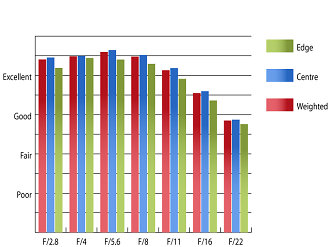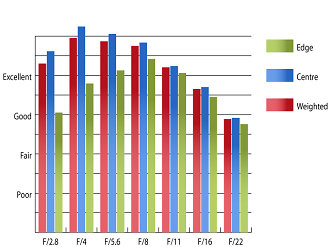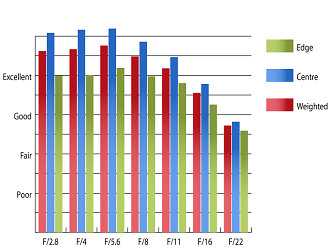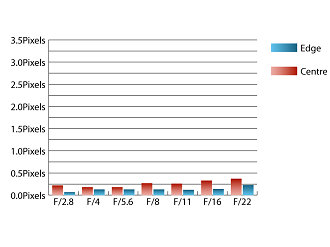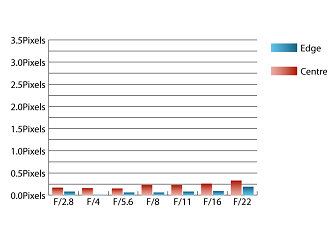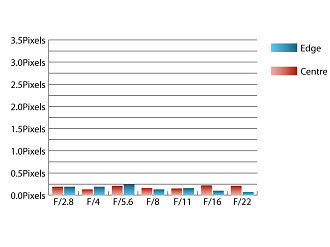Fujifilm XF 50-140mm f/2.8 R OIS WR Lens Review
Fujifilm XF 50-140mm f/2.8 R OIS WR Performance
At 50mm, sharpness already approaches outstanding levels in the centre of the frame at maximum aperture and the clarity achieved towards the edges of the frame is excellent. Stopping down improves performance slightly, with peak performance being achieved between f/4 and f/5.6.
Zooming to 90mm results in outstanding sharpness in the centre of the frame at maximum aperture, although performance towards the edges has fallen away somewhat, with good levels of sharpness just being attained at f/2.8. Stopping down improves performance, especially towards the edges of the frame, reaching a peak at f/8.
Finally, at 140mm, sharpness in the centre of the frame is still outstanding at maximum aperture, and performance towards the edges of the frame is back up to excellent levels. Stopping down has little effect, with the lens performing much the same down to f/8 at this focal length.
How to read our charts
The blue column represents readings from the centre of the picture frame at the various apertures and the green is from the edges. Averaging them out gives the red weighted column.The scale on the left side is an indication of actual image resolution. The taller the column, the better the lens performance. Simple.
For this review, the lens was tested on a Fujifilm X-T1 using Imatest.
Chromatic aberrations are extremely well controlled for a lens of this type, with fringing barely exceeding a quarter of a pixel width at any zoom setting or aperture. This low level of CA shouldn't cause any issues, even in harsh crops from the edges of the frame, or in large reproductions.
How to read our charts
Chromatic aberration is the lens' inability to focus on the sensor or film all colours of visible light at the same point. Severe chromatic aberration gives a noticeable fringing or a halo effect around sharp edges within the picture. It can be cured in software.Apochromatic lenses have special lens elements (aspheric, extra-low dispersion etc) to minimize the problem, hence they usually cost more.
For this review, the lens was tested on a Fujifilm X-T1 using Imatest.
Falloff of illumination towards the edges of the frame is well controlled for a lens of this type. At 50mm the corners are 1.26 stops darker than the image centre at maximum aperture and at 140mm the corners are 1.59 stops darker. Visually uniform illumination is achieved with the lens stopped down to f/5.6 or beyond throughout the zoom range.
Distortion is reasonably well controlled for a lens of this type. Imatest was able to detect 0.566% pincushion distortion at 50mm and 1.47% pincushion at 140mm. Automatic correction of distortion in camera is very good, and this information can be read by many popular raw image converters, which should mean that distortion is rarely noticeable in practice.
With, or without, the petal-shaped hood attached, this lens is extremely resistant to flare, thanks to a combination of Fujifilm's Super-EBC coatings, combined with a newly developed Nano-GI coating. As a result, it also copes well with shooting into the light retaining good contrast.
Value For Money
This 50-140mm lens from Fuji costs around £1200, which may seem like a lot, but if you compare it to comparable alternatives for other camera systems, it really isn't that expensive at all, especially given how well the lens performs.
There are currently no comparable lenses available for Fuji X-series cameras as currently, Fujifilm have a monopoly on lenses for their own lens mount.
Add your message
Please login here or if you've not registered, you can register here. Registering is safe, quick and free.
photodo Stats
428 MTF tests
74 in-depth photodo reviews
100+ users join each day
Help the lens community by reviewing or rating a lens today via our lens search
Latest Lens Reviews
- Chinon 28mm f/2.8 Vintage Lens Review
- Canon EF 70-200mm f/4L IS II USM Lens Review
- Samyang AF 85mm f/1.4 EF Review
- Sigma 70mm f/2.8 DG Macro Art Review
- Samyang AF 24mm f/2.8 FE Review
- Meike 50mm f/1.7 Review
- Tamron 70-210mm f/4 Di VC USD Review
- Lensbaby Burnside 35mm f/2.8 Review
- Asahi Super Takumar 50mm f/1.4 Review
- Asahi Super-Multi-Coated Takumar 135mm f/3.5 Review
